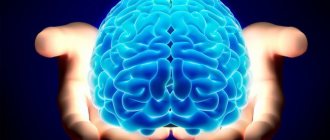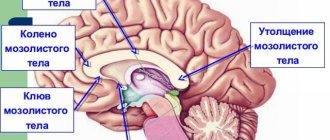An unusual disease in which a person is unable to control his own sleep and wakefulness is called “narcolepsy.” It comes from the Greek words narkē, meaning numbness, and lēpsis, meaning sleep.
This neurological disorder is also called paroxysm of intractable sleepiness or Gelineau's disease. This French neurologist first described this disease in the late seventies of the 19th century. For several years, Jean Baptiste Edouard observed a 38-year-old wine merchant who went to the doctor with his problem.
A man could fall asleep up to two hundred times during the day while eating, sitting in a theater chair at a performance, or while talking - starting to speak and “passing out” mid-sentence. During intense experiences and a surge of emotions, his drowsiness was accompanied by a loss of muscle tone, and he fell. His consciousness remained quite clear. Gelineau called this case cataplexy.
Doctor Samuel Brock (USA) in 1928 discovered another form of narcolepsy, which he called sleep paralysis. His patient, a twenty-two-year-old boy, suffered from attacks of drowsiness and catalepsy, but these were also followed by a temporary inability to move and speak. In this state, he experienced very plausible hallucinations, which were generally unusual for him.
Causes of a special illness
Narcolepsy is a fairly rare disease (affects 1 person out of 2 thousand). It develops mainly in 20-50 year old men, but can also appear in childhood. Despite its low prevalence, this pathology is very dangerous, because an individual can suddenly fall asleep at any moment and anywhere while performing some action. Such an attack cannot be controlled and therefore interferes with normal activities - it is impossible to properly study, work, do everyday activities, or drive a car. All this negatively affects personal and social life. Children with this disease are developmentally delayed.
The sensations of those suffering from narcolepsy are similar to those experienced by people who have not slept for two days, and this reduces the quality of life.
Researchers cannot explain the exact cause of drowsiness syndrome, since it has not been studied enough due to its uniqueness. However, it turned out that psychological and psychiatric problems are not to blame.
Currently, the following factors for the development of the disease are called:
- heredity;
- lack of special genes of hypocretins (orexins) - neurotransmitters that ensure the transmission of signals to sleep and awakening in the brain;
- dysfunction of the immune system;
- overwork;
- severe infections;
- skull injuries;
- viral diseases;
- malfunctions of the endocrine glands, including the pituitary gland.
Sleepy during the day and at night, narcoleptics often have trouble falling asleep or constantly wake up. This is associated with abnormalities in the areas of the brain that regulate the main stages of sleep: the rapid phase occurs earlier than normal, and the deep phase is absent altogether.
Causes of the disease
To date, doctors cannot identify specific causes that directly cause narcolepsy. However, long-term research, which has been actively and quite successfully carried out over the last hundred years, allows us to make some well-founded assumptions.
It is believed that the main cause of unreasonable sleepiness is a lack of orexin, also known as hypocretin.
This is a substance (the so-called neurotransmitter) that is responsible for the uninterrupted transmission of nerve impulses between cells in the body, as well as for appetite and sleep - the body’s energy resources.
Drowsiness occurs when the coherence of this process is disrupted. This is exactly the kind of failure that occurs during normal fatigue, but in this case it is natural. But doctors and scientists have not yet figured out why it occurs, causing narcolepsy.
However, there are some factors that lead to a decrease in orexin levels:
We recommend reading! Click on the link:
How long can a person go without sleep without harm to health?
- Nervous exhaustion of varying degrees.
- Diabetes.
- Infectious diseases affecting the nervous system.
- Hereditary predisposition.
- Brain injuries, concussions.
All reasons are related to the nervous system, and this is understandable. The mechanism of nervous diseases works on the principle of blocking the transmission of nerve impulses, since the brain perceives some of them as “hostile”, and in this aspect the body, in fact, works against itself.
Thus, the causes of narcoleptic syndrome are both the predisposition of the body and the person’s lifestyle. When these two reasons begin to work together, the disease is practically unavoidable.
Manifestations of paroxysm of irresistible drowsiness
Symptoms of the disease first appear in adolescents or young adults, either immediately, or worsen gradually as they grow older:
- Strong desire to sleep during the day, despite a sufficient amount of sleep at night. Such irresistible drowsiness interferes with normal activity, as it is accompanied by lethargy, foggy thinking, apathy, and difficulty concentrating. A person feels “broken,” “squeezed like a lemon,” and constantly tired. He is not in the mood, he is constantly irritated, cannot remember important information, and loses motivation. At any moment and under any circumstances, the patient can fall asleep, and such attacks occur several times a day. It is easy to wake him up and after waking up he, just for a while, feels rested.
- Disturbance of normal sleep at night - frequent awakenings or insomnia.
- Cataplexy – with strong emotions (surprise, laughter, joy, rage, etc.) a sudden loss of muscle tone occurs. A person may fall due to weakness in the legs, arms become numb, and the head “falls.” Such an attack can last a moment or last half an hour.
- When falling asleep or waking up, terrible, very believable hallucinations arise, visual or in the form of sensations and sounds. They scare and even threaten.
- Sleep paralysis - waking up, the patient cannot move or say anything, but thinks quite adequately.
- Automaticity – performing actions “on autopilot”. A person may fall asleep but continue what he was doing while awake without realizing it. This is dangerous, since sleep can occur while driving a vehicle, cooking, etc.
People suffering from narcolepsy also complain of memory loss, double vision, and headaches.
If you have the above symptoms, you should consult a specialist for diagnosis and subsequent treatment. Unfortunately, it is impossible to completely get rid of this neurological disorder, but it is quite possible to correct it and thereby improve the quality of life.
How to awaken the body?
A person who gets up early every day constantly says about himself: “I sleep on the go.” To feel energized and have a productive day, use these tips:
- Open all curtains to let plenty of light into the room. If it's cloudy outside, provide good artificial lighting.
- Lack of fluid in the body leads to loss of strength. Drink as much water as possible throughout the day if you want to feel energized.
- Always have breakfast, because food helps the body wake up. Your diet should contain as much protein as possible.
- Move more. If you have a sedentary job, roll your neck in different directions. And if possible, walk around the office, jump and even do a few squats.
- Learn to breathe with your belly. Take a few quick breaths if you feel sleepy.
- Train yourself to wake up and work to active, rhythmic music. You need to choose tracks that make your body dance on its own.
- To get rid of drowsiness, you need oxygen. Open a window or go outside to breathe in some fresh air.
- Start your morning with a shower (it’s better if it’s contrasting). If you feel sleepy in the middle of the day, just wash your face with cold water.
- If you really want to sleep, it will be useless to fight your body. Give yourself a rest for 15-30 minutes, then start working with renewed vigor.
Diagnostic features
Only a neurologist - somnologist, that is, a doctor specializing in sleep disorders, can make an accurate diagnosis of narcolepsy. It will not be possible to do this right away, since there are quite a lot of violations in this area for various reasons. Some doctors may not even remember the presence of such a disease as paroxysm of irresistible drowsiness - it is so rare.
First of all, the specialist will need to assess the general condition of the patient, which makes it possible to exclude other ailments that have similar symptoms. To do this, the doctor will study the medical history and conduct comprehensive studies in the somnology laboratory.
There are two tests to determine what kind of pathology a patient has:
- Polysomnography. Small electrodes are attached to the skin of a person in an isolated room using a jelly-like substance. They allow you to record intracerebral waves, heartbeat rhythm, eye movements, and muscle activity.
- The MSLT test is done after the previous one, but on the next day. Electrodes are also attached to the patient's body and the patient is allowed to fall asleep for 20 minutes. Several such attempts are made, maintaining an interval of 2 to 3 hours.
The results of these studies will provide data on the course of the disease and determine whether the presence of narcolepsy can be confirmed or whether the patient is affected by another disease associated with sleep disturbances and similar symptoms.
In addition to the above-mentioned procedures, an encephalogram of the brain is also necessary for this.
Why do you sleep on the go?
No one likes to feel like a “sleepy fly,” because every person wants to be active and work productively. To fix the problem, you need to answer the question: “Why do I sleep on the go?” The reasons may be as follows:
- Breathing disturbances during sleep. If a person is out of breath or snoring, they will wake up feeling tired and groggy.
- Uncomfortable conditions (uncomfortable bed, stale air in the room, incorrect air temperature in the room). As a result, a person does not get proper rest.
- Taking sleeping pills often leads to drowsiness, since the effect of most of them lasts more than 6 hours. Thus, the human body is awake, but the brain still continues to sleep.
- Chronic fatigue associated with low hemoglobin levels, hypovitaminosis and oxygen starvation.
- A sedentary lifestyle is accompanied by the accumulation of lactic acid in the muscles, which causes a sleepy state.
Symptomatic treatment
First of all, patients with narcolepsy are advised to lead a certain lifestyle:
- give up “heavy” foods, caffeine, alcohol, smoking;
- observe a sleep schedule - reduce daytime sleep, increase nighttime sleep, go to bed and get up at the same time;
- doing physical exercise;
- plan a schedule of your actions so that while performing certain actions (for example, driving a car) you are especially vigilant and careful. It is better to have someone nearby during this period.
To control sleep disturbances, drowsiness, and avoid hallucinations, the doctor prescribes certain medications to the patient - stimulants, antidepressants, etc. His recommendations should be strictly followed and any problem or change should be reported immediately.
Good news came out not long ago. Based on scientists’ assertion that one of the causes of narcolepsy is a lack of orexin in the brain (discussed above), a nasal spray containing it was developed. So far the drug has only been tested on monkeys, but after using it the animals were alert even with a lack of sleep. The military is interested in the development, but there is hope that it will reach the sick!
Behavioral therapy is also indicated. Family members of a person suffering from narcolepsy, as well as colleagues and superiors, should know about his illness - the attending physician should be the first to inform about this, and the patient himself should inform the rest. This makes it possible to avoid a lot of misunderstandings - those around you will understand the patient’s behavior and not think that he is deliberately shirking work, is lazy, becomes depressed, or suffers from a mental disorder.
Relatives will support the narcoleptic relative and help cope with the symptoms of the pathology. As for work, the employer, if possible, will create certain conditions if it is interested in such an employee. If not, then the patient will have to look for another source of income where his problem will not interfere with the performance of his official duties.
Parents of a child with such a disease should warn teachers about it. Teachers will definitely take measures to ensure that the student is not ridiculed, the educational process does not suffer, etc. The diagnosis will not be an obstacle to good performance and education.
Symptoms of sudden sleep
Sudden falling asleep and increased sleepiness are only one of the manifestations of the disease.
What symptoms are characteristic of narcolepsy?
- Cataplexy is a state of short-term paralysis of the entire body (or individual organs) while maintaining consciousness.
- Hallucinations – hypnagogic (during falling asleep) and hypnopompic (during awakening).
- Anxiety.
- Tachycardia.
- Headache.
- Involuntary muscle twitching.
- Absent-mindedness.
- Night insomnia.
The last point seems paradoxical, but it is indeed one of the main symptoms of narcolepsy. At night the patient cannot fall asleep; Outwardly, his condition looks as if during the day he is compensating for nighttime insomnia. This indicates that a certain mechanism in the body that regulates sleep and wakefulness has gone wrong.
Often the patient begins to dream before actually falling asleep. Suddenly he notices how reality begins to slowly blur, and fantastic images appear in its place. This is a kind of “daydream” that can end in a complete “blackout”. But it happens that falling asleep occurs suddenly, without any “preparation.”
If a narcoleptic is touched during a sudden sleep, he will come out of the state of paralysis and open his eyes; however, he may then “switch off” again and continue to experience the attack.
Sleep paralysis is essentially a form of cataplexy. With narcolepsy, it often occurs immediately after waking up and lasts from a few seconds to several minutes. At the same time, the person is conscious, adequately assesses the situation around him, but cannot move.
Russian neurologist Alexander Vein identified five signs of narcoleptic syndrome: nighttime insomnia, attacks of drowsiness, hypnagogic hallucinations, catalepsy as such, and catalepsy of awakening (a state of paralysis immediately after the patient wakes up). To make a diagnosis, only falling asleep during the day in combination with at least one of these five signs is sufficient.
It has been established that the disease most often affects adolescents and young adults, most often men; In women and young children, narcolepsy is quite rare.
Things to keep in mind
Narcolepsy, unfortunately, accompanies a person throughout his life; its symptoms either stabilize or become more severe. Only through treatment and following the recommendations of a somnologist can you make attacks less frequent and weaker, and lead a completely normal socially active life.
And one more thing... Researchers recently found out that the great Leonardo da Vinci suffered from such a disease. She struck him after a three-year stay in the cellars of the Palazzo Ducale (Doge's Palace) in Venice. The thinker, engineer, artist, ahead of his time, managed to turn illness to his advantage. He built a wheelchair and it was always next to him - so the attacks of sleep did not take him by surprise. Leonardo almost never parted with a pencil and paper, so immediately after waking up he drew what he had imagined. So narcolepsy contributed to the creativity of a genius.
Narcolepsy - how to treat?
A normal quality of life is the main need of a seriously ill person, and narcolepsy is no exception.
The diagnosis is made based on the patient’s complaints and a detailed examination by a somnologist. The doctor prescribes polysomnography (an overnight sleep study in a laboratory, tracking sleep phases with a special device) and an MSLT test (in a daytime sleep study in a laboratory). Based on the tests, the dynamics of sleep patterns are compiled, and the presence/absence of the disease can be judged. Timely consultation with a doctor and well-designed therapy significantly alleviate the condition of a patient with narcolepsy. A narcoleptic takes medications in a prophylactic dose throughout his life, this allows him to reduce the number of attacks and achieve remission. Narcolepsy syndrome caused by another disease is to eliminate the underlying disease. An effective treatment regimen includes drugs:
- antidepressants – significantly reduce episodes of cataplexy and sleep paralysis;
- stimulants – eliminate drowsiness, improve human productivity during the day;
- sleeping pills – stabilize night sleep.
Narcolepsy - treatment with folk remedies
Narcolepsy is curable, many herbalists and healers believe, but this is not true. Traditional medicine can be an additional aid to drug therapy. A doctor's consultation is required. Herbs used for the disorder:
- motherwort decoction - sedative effect;
- dill seed – mild sedative and hypnotic effect;
- hawthorn fruits – eliminate insomnia;
- hop cones – relaxing effect;
- Melissa – normalizes mental processes.
Theories, facts and fiction
For many centuries, the causes of narcolepsy remained a mystery to everyone.
A variety of versions were voiced, for example, one German doctor even expressed a theory according to which this disease developed in adolescents as a result of excessive masturbation. At one time, narcolepsy was considered a mental disorder, then it was one of the symptoms of schizophrenia. With the development of medicine, scientists began to “dig” deeper and hypothesized that the disease develops as a result of an unstable neurochemical brain balance.
However, the real cause of the disease was only accurately established at the end of the 20th century. According to official conclusions, the disease develops after disturbances in the body system responsible for the REM sleep phase. As evidence, scientists cite experiments that Pavlov once conducted.
It was he who at one time established that the human brain is a very complex structure in which there are deep “mechanisms” responsible for sleep. The main elements of the brain are neurons that transmit various impulses and biologically active substances from one place to another.
When a person’s nervous system is in a working active state, he is awake and engaged in some activity. However, if he gets overtired or is in an excited state for a long time, he will immediately feel the attacks of sleep and want to rest.
If any disruptions occur in the nervous system, sleep can occur involuntarily in a person at any time of the day. Basically, these disorders are associated with a lack of orexin A and orexin B. It is these neurotransmitters that are responsible for the state of wakefulness and a smooth transition to sleep.
The main reasons for the development of narcolepsy:
- brain infections;
- severe head and brain injuries;
- systematic excessive fatigue;
- dysfunction of the immune system;
- hormonal imbalances;
- genetic predisposition to this type of disease;
- constant emotional stress;
- systematic lack of sleep;
- mental trauma;
- diabetes;
- Sometimes the first signs of the disease are observed during pregnancy.
It should be taken into account that in most cases, the exact cause of this disease in a particular person may be impossible to establish. Very often, a whole range of problems can lead to this.
Different types of Gelineau syndrome
Narcolepsy, also called Gelineau's syndrome after its discoverer, is a pathology that is manifested by sleep disorders, in particular hypersomnia .
There are different types of narcolepsy :
- Primary narcolepsy: This is the classic form of narcolepsy with characteristic episodes of daytime hypersomnia, cataplexy (weakness, sudden decrease in muscle tone), hallucinations and sleep paralysis.
- Secondary narcolepsy: A rarer form of narcolepsy that develops as a result of traumatic brain injury, diseases such as multiple sclerosis and brain tumors, and damage caused by inflammation.
- Paroxysmal narcolepsy: This is a condition associated with epilepsy, the facts of narcoleptic paroxysmal crisis are one of the symptoms that appear during epileptic seizures and which consist of sudden falling asleep followed by falling.
- Narcolepsy without cataplexy: is a less common form of primary narcolepsy and is characterized by the absence of cataplexy as a symptom. It can exist in two variants, without cataplexy, but with the presence of episodes of REM sleep, determined using diagnostic tests (in this case, defined as monosymptomatic narcolepsy) or without cataplexy and without episodes of REM sleep.









